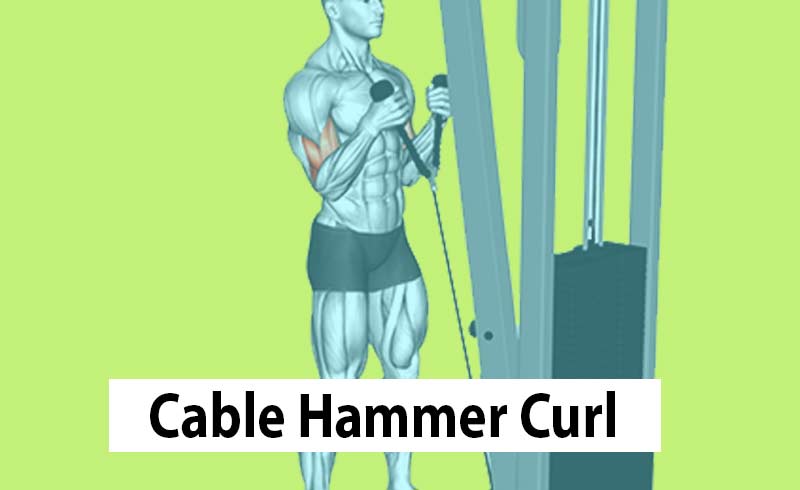As fitness enthusiasts, we all want to have toned and sculpted arms that we can show off with pride. One exercise that can help us achieve this goal is the Cable Hammer Curl.
By incorporating cable hammer curls into your workout routine, you can strengthen your upper arms, and prevent injury. Moreover, you can achieve the impressive bicep gains you’ve been striving for.
In this exercise guide, we will go over the benefits of this exercise, proper form and technique, different variations and alternatives, and tips for maximizing your results.
What Is A Cable Hammer Curl?
A cable hammer curl is a strength-training exercise that targets the biceps muscles.
This movement involves pulling a cable towards the body by flexing the elbows while holding weights attached to the cable. Cable hammer curls can be done standing or sitting and are usually performed with controlled movements.
Related Workout: Ultimate Biceps Development With Dumbbell Supinated Curls.
Rope Hammer Curl Muscles Worked
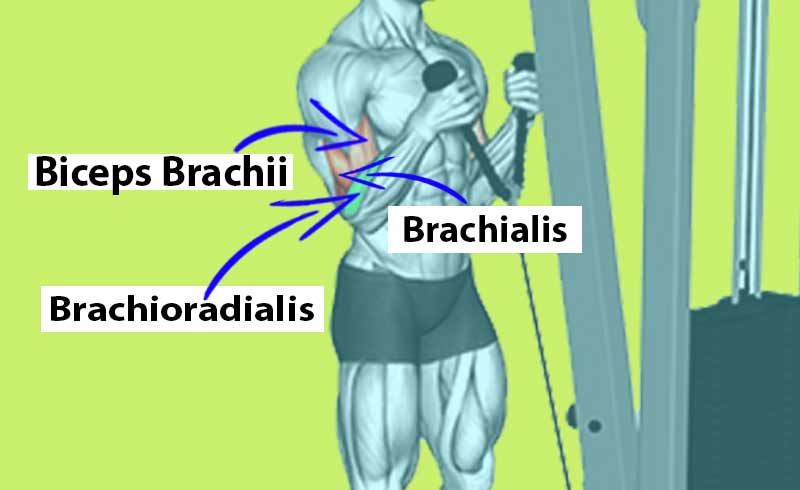
The brachialis and brachioradialis are the primary muscles targeted by the cable hammer curl in both the upper and lower arm.
A few synergist muscles are used during the hammer curl such as the biceps brachii
Several other muscles are used as stabilizers like Obliques, and abdominal muscles.
How to Perform Cable Hammer Curls Properly?
To properly perform cable hammer curls, there are a few steps that you should follow:
- Firstly, stand straight in front of the cable machine and grab the handle with an overhand grip. Your palms should be facing each other (neutral grip).
- Next, keep your elbows pinned to your sides and extend your arms completely so that the cables are taut.
- Now, exhale and curl your forearms towards your biceps while contracting them simultaneously.
- Make sure you avoid swinging or jerking movements during this motion.
Cable Hammer Curl Benefits
- Targets Multiple Muscle Groups: The Cable Hammer Curls exercises target forearms and brachialis muscle in addition to the biceps, this results in a more even development and stronger arms overall.
- Activates More Muscle Fibers: Research indicates that Cable Hammer Curls activate multiple muscle fibers in the biceps compared to typical bicep curls. By doing so, each repetition will yield more benefits, helping to maximize your gains.
- Provides More Variety: Adding this exercise to your arm workout routine can provide more variety and prevent boredom. In addition, it’s prudent to incorporate various workouts to prevent a workout from plateauing.
Offers Better Grip Strength: Since this type of Cable Curls requires you to hold onto a rope attachment, they can improve your grip strength over time. This can benefit your other lifts and everyday activities as well.
Reduces Stress on Elbows: Compared to other bicep exercises like barbell curls, Cable Hammer Curls place less stress on your elbows. This can be especially beneficial if you’re dealing with elbow pain or injury.
What Are The Best Variations Of A Rope Hammer Curl?
Are you seeking to modify your bicep workout? Here are four alternative exercises to the cable hammer curl that you can try:
1. Dumbbell Hammer Curl:

To perform the hammer curl exercise follow these steps:
- Grab two dumbbells. After that, stand with both feet at shoulder width apart.
- Your elbows must be at your sides and palms should face each other while grasping the dumbbells.
- Keep your elbows stationary then curl the weights up towards your shoulders.
- lower the dumbbells back down to their starting position slowly and repeat for the desired reps.
Check out this variation of a dumbbell hammer curl
2. Reverse Grip Barbell Curl:
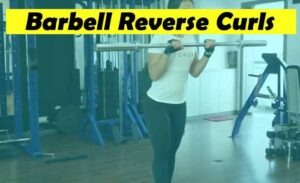
For an alternative variation to cable hammer curl, try out the reverse grip barbell curl which targets different muscles in your arms by having you lift weights with an underhand grip.
- Your grip should be underhand with both hands at a distance equal to the width of your shoulders.
- Curl the barbell towards your chest while maintaining a fixed elbow position.
- Perform repetitions by lowering the barbell back to its starting position using a controlled movement.
3. Zottman Curl:

The Zottman curl is a unique variation that targets both the biceps and forearms.
- Hold a pair of dumbbells with your palms facing up and your elbows at your sides.
- Curl the weights up towards your shoulders while keeping your elbows stationary.
- Once at the top, rotate your palms so they’re facing down, and slowly lower the dumbbells back down to the starting position.
- Repeat for desired reps.
4. Incline Bench Dumbbell Curl:
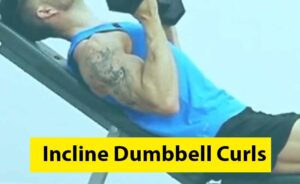
- With 2 dumbbells in both hands, sit down on an inclined bench.
- Lean backward until the bench cradles your head and shoulders.
- Make sure to hold the dumbbells with your palms facing up and positioned near the side of each elbow.
- Cur the weights upward towards shoulder height without bending or lifting your elbows.
- slowly lower the dumbbells back down to their initial position.
- Repeat for desired reps
Your arms can benefit from incorporating these alternative exercises that will provide variety to the routine and challenge different muscle groups.
5. Cross Body Hammer Curl:

Performing the cross-body hammer curl requires a pair of dumbbells and is intended to develop the biceps, brachialis, and forearm muscles.
Unlike traditional curls where you lift weights directly in front of your body, this exercise involves lifting them across the torso instead.
This approach leads to increased tension on the long head of your biceps, making it an excellent option for developing your outer bicep if that is an area that needs attention.
6. Single Arm Cable Hammer Curls:
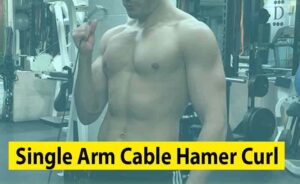
To isolate and concentrate on your biceps, perform single-arm cable hammer curls. This exercise is fitting for those after stronger, sizable arms. Let’s delve into how it’s executed:
- Begin with picking the appropriate weight on the cable machine. Attach a lone handle to the cable and rearrange the height so that it meets shoulder level.
- Face towards the machine with your legs positioned shoulder-width apart. With an underhand grip (palms upwards), clutch onto the handle and lengthen your arm completely
- Bring up the handle towards your shoulder while your elbow is near your body.
- Once you reach the top of the motion, remember to contract and hold (squeeze)your bicep for about a second before slowly returning the handle down to its starting point with a completely straight arm.
- Complete as many reps as necessary on one side before proceeding with switching sides.
Cable Hammer Curls Vs Dumbbell
Comparing the cable curl with the dumbbell hammer curl yields insights into the advantages and disadvantages of each approach.
Dumbbell hammer curls challenge the body at a 90-degree flexion point, while cable hammer curls allow for steady, reliable tension throughout their execution.
Though dumbbells are available and more economically accessible for home training, they lack the benefits of a cable setup that enables consistent resistance through your exercises.
Cable curls also offer better joint support than free weights.
For optimum results, it is suggested that one engages in both types of exercise. Not only will you experience the enjoyable pump and burn sensation that cables are known for, but you will also achieve the intense tension that tears muscle fibers with heavier free weights.
Therefore, incorporating a balance of these exercises into your routine can help enhance your fitness journey.
FAQs
Can you do hammer curls on cables?
Absolutely! Cable hammer curls are a great variation of the traditional hammer curl and can be done using a cable machine. In fact, they offer a few advantages over the traditional dumbbell hammer curl.
Are cable hammer curls better than dumbbells?
When comparing cable hammer curls and dumbbell hammer curls, there is no definitive winner. Each exercise possesses distinct advantages and can efficiently target multiple muscle groups such as biceps and forearms. The optimal approach would be to integrate both of them into your workout routine for an exhaustive arm workout, creating variation throughout your exercises for better results.
Conclusion: Are cable hammer curls good?
Yes, including cable hammer curls in your arm workout regimen is a clever choice. The reason is that they supply steady tension, have an assortment of grip options and attachments to select from, and are less straining on the wrists as well as the elbows.
References & Sources:
- Gorman, N. (2020, October 29). Brachialis muscle. Kenhub. https://www.kenhub.com/en/library/anatomy/brachialis-muscle
- Melrose, Don PhD, CSCS*D Exercise Technique, Strength and Conditioning Journal: February 2014 – Volume 36 – Issue 1 – p 92-93 doi: 10.1519/SSC.0b013e318297a092
- Kulig, K., Powers, C. M., Shellock, F. G., & Terk, M. (2001). The effects of eccentric velocity on activation of elbow flexors: evaluation by magnetic resonance imaging. Medicine and Science in Sports and Exercise, 33(2), 196–200. https://doi.org/10.1097/00005768-200102000-00004
- Bench Press Calculator - April 22, 2024
- Press to Handstand: Ultimate Step-by-Step Guide - April 22, 2024
- Cable Press (How To Do, Benefits, Targeted Muscles, Alternative) - April 22, 2024

